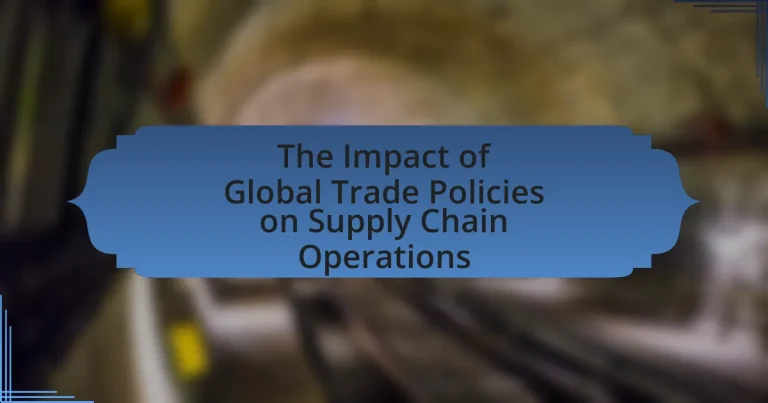Global trade policies are essential regulations and agreements that shape international trade, influencing tariffs, trade barriers, and import/export restrictions. These policies significantly impact supply chain operations by determining costs, sourcing strategies, and logistics efficiency. Key components include tariffs, trade agreements, and customs regulations, which can alter procurement practices and affect market access. Companies face risks from changing trade policies, such as increased costs and supply chain disruptions, but can adapt by diversifying suppliers and leveraging technology for real-time data analysis. The article explores the intricate relationship between global trade policies and supply chain dynamics, highlighting strategies for businesses to navigate these challenges effectively.
What are Global Trade Policies and Their Role in Supply Chain Operations?
Global trade policies are regulations and agreements that govern international trade between countries, influencing tariffs, trade barriers, and import/export restrictions. These policies play a crucial role in supply chain operations by determining the cost and feasibility of sourcing materials and distributing products across borders. For instance, the World Trade Organization (WTO) facilitates trade agreements that can lower tariffs, thereby reducing costs for businesses and enhancing supply chain efficiency. Additionally, trade policies can impact supply chain strategies by encouraging companies to diversify suppliers or relocate production to countries with favorable trade terms, ultimately affecting global logistics and inventory management.
How do global trade policies influence supply chain dynamics?
Global trade policies significantly influence supply chain dynamics by determining tariffs, trade agreements, and regulations that affect the flow of goods across borders. For instance, the implementation of tariffs can increase costs for imported goods, prompting companies to reassess their sourcing strategies and potentially shift production to countries with lower tariffs or more favorable trade agreements. Additionally, trade agreements, such as the United States-Mexico-Canada Agreement (USMCA), can facilitate smoother trade by reducing barriers, thereby enhancing supply chain efficiency. According to a study by the World Bank, changes in trade policies can lead to a 10-20% variation in trade volumes, illustrating the direct impact of these policies on supply chain operations.
What are the key components of global trade policies?
The key components of global trade policies include tariffs, trade agreements, import/export regulations, and trade facilitation measures. Tariffs are taxes imposed on imported goods, influencing pricing and competitiveness. Trade agreements, such as free trade agreements, establish the terms of trade between countries, promoting or restricting trade flows. Import/export regulations govern the legal requirements for trading goods across borders, ensuring compliance with national laws. Trade facilitation measures aim to simplify and streamline customs procedures, reducing delays and costs associated with international trade. These components collectively shape the landscape of global trade, impacting supply chain operations by affecting costs, efficiency, and market access.
How do tariffs and trade agreements affect supply chains?
Tariffs and trade agreements significantly influence supply chains by altering costs and access to markets. Tariffs increase the cost of imported goods, which can lead to higher prices for consumers and reduced demand, prompting companies to seek alternative suppliers or adjust their sourcing strategies. For instance, the U.S.-China trade war resulted in increased tariffs on hundreds of billions of dollars’ worth of goods, compelling many companies to relocate their supply chains to countries with lower tariffs, such as Vietnam or Mexico. Conversely, trade agreements, like the United States-Mexico-Canada Agreement (USMCA), facilitate smoother trade by reducing tariffs and regulatory barriers, encouraging companies to integrate their supply chains across member countries. This integration can enhance efficiency and reduce costs, as seen in the automotive industry, where manufacturers benefit from tariff-free access to a larger market.
Why are global trade policies important for businesses?
Global trade policies are important for businesses because they establish the rules and regulations governing international trade, which directly affect market access, costs, and competitiveness. These policies can influence tariffs, quotas, and trade agreements, impacting how businesses operate across borders. For instance, the World Trade Organization (WTO) facilitates trade by promoting lower tariffs and reducing trade barriers, which can lead to increased export opportunities for businesses. Additionally, according to a report by the International Trade Centre, businesses that engage in international trade can experience up to 20% higher productivity compared to those that do not, highlighting the significance of favorable trade policies in enhancing business performance.
What risks do companies face due to changing trade policies?
Companies face several risks due to changing trade policies, including increased costs, supply chain disruptions, and market access challenges. For instance, tariffs imposed on imported goods can raise production costs, leading to higher prices for consumers and reduced competitiveness in global markets. Additionally, changes in trade agreements can disrupt established supply chains, causing delays and inefficiencies. According to a report by the World Trade Organization, trade policy changes can lead to a 10-20% increase in logistics costs for affected companies, highlighting the financial impact of such risks. Furthermore, companies may encounter barriers to entry in new markets or face restrictions that limit their ability to operate internationally, which can hinder growth and profitability.
How can businesses adapt to shifts in global trade regulations?
Businesses can adapt to shifts in global trade regulations by implementing flexible supply chain strategies that allow for quick adjustments to new compliance requirements. This includes investing in technology for real-time data analysis to monitor regulatory changes, training staff on new trade policies, and diversifying suppliers to mitigate risks associated with sudden regulatory shifts. For instance, companies that utilize supply chain management software can quickly assess the impact of tariffs or trade agreements on their operations, enabling them to make informed decisions. Additionally, businesses that engage in proactive communication with trade experts and legal advisors are better positioned to navigate complex regulatory landscapes, ensuring compliance and minimizing disruptions.
What are the Effects of Global Trade Policies on Supply Chain Operations?
Global trade policies significantly influence supply chain operations by altering tariffs, trade agreements, and regulatory standards. These policies can lead to increased costs or savings in logistics, affecting sourcing decisions and inventory management. For instance, the implementation of tariffs can raise the cost of imported goods, prompting companies to seek alternative suppliers or adjust their pricing strategies. Additionally, trade agreements like the US-Mexico-Canada Agreement (USMCA) can streamline customs processes, enhancing efficiency in cross-border trade. According to a study by the World Bank, changes in trade policies can impact global supply chains by shifting trade flows and altering competitive dynamics, ultimately affecting profitability and operational strategies for businesses engaged in international trade.
How do trade policies impact sourcing and procurement strategies?
Trade policies significantly influence sourcing and procurement strategies by altering the cost structures and availability of goods. For instance, tariffs imposed on imported goods can increase procurement costs, prompting companies to seek alternative suppliers or local sources to mitigate expenses. Additionally, trade agreements can facilitate smoother cross-border transactions, encouraging businesses to diversify their sourcing strategies and enhance supply chain resilience. According to a study by the World Trade Organization, trade policies directly affect global supply chains, as companies adapt their procurement practices in response to changing regulations and market conditions.
What challenges do companies face in sourcing materials internationally?
Companies face several challenges in sourcing materials internationally, including regulatory compliance, fluctuating tariffs, and supply chain disruptions. Regulatory compliance involves navigating different countries’ laws and standards, which can vary significantly and complicate procurement processes. Fluctuating tariffs, influenced by changing trade policies, can increase costs unpredictably, impacting budgeting and pricing strategies. Additionally, supply chain disruptions, often caused by geopolitical tensions or natural disasters, can lead to delays and shortages, affecting production timelines. According to a 2021 report by the World Trade Organization, trade tensions and policy changes have led to increased uncertainty in global supply chains, highlighting the complexities companies must manage when sourcing materials internationally.
How can companies optimize procurement in response to trade policies?
Companies can optimize procurement in response to trade policies by diversifying their supplier base and leveraging technology for better data analysis. Diversification reduces dependency on single sources, mitigating risks associated with tariffs or trade restrictions. For instance, a study by the World Bank indicates that firms with multiple suppliers can better navigate fluctuations in trade policies, as they can shift sourcing strategies quickly. Additionally, utilizing procurement software enhances visibility into supply chain dynamics, allowing companies to make informed decisions based on real-time data regarding tariffs, compliance requirements, and market conditions. This strategic approach not only ensures compliance with trade regulations but also enhances overall supply chain resilience.
What is the impact of trade policies on logistics and transportation?
Trade policies significantly influence logistics and transportation by determining tariffs, trade agreements, and regulations that affect the flow of goods across borders. For instance, the implementation of tariffs can increase shipping costs, leading to higher prices for consumers and reduced demand for imported goods. Additionally, trade agreements, such as the United States-Mexico-Canada Agreement (USMCA), can streamline customs procedures and reduce barriers, facilitating smoother transportation and logistics operations. According to the World Trade Organization, trade policies that promote free trade can enhance global supply chain efficiency, as they encourage competition and innovation among logistics providers.
How do tariffs influence shipping costs and routes?
Tariffs increase shipping costs and can alter shipping routes by imposing additional fees on imported goods. When tariffs are applied, companies often pass these costs onto consumers, leading to higher prices for imported products. This financial burden may incentivize businesses to seek alternative shipping routes or suppliers in countries with lower tariffs or no tariffs, thereby changing established logistics patterns. For example, the U.S.-China trade war resulted in increased tariffs, prompting many companies to reroute shipments through other countries to mitigate costs, as evidenced by a 2019 report from the Federal Reserve indicating shifts in trade flows due to tariff impacts.
What role do customs regulations play in logistics efficiency?
Customs regulations significantly enhance logistics efficiency by streamlining the movement of goods across borders. These regulations establish clear guidelines for documentation, tariffs, and inspections, which help reduce delays and uncertainties in the supply chain. For instance, the World Bank’s “Doing Business” report highlights that countries with efficient customs processes can reduce border clearance times by up to 50%, thereby lowering overall logistics costs and improving delivery times. Consequently, adherence to customs regulations not only facilitates smoother operations but also fosters international trade by ensuring compliance and minimizing the risk of penalties or confiscations.
How Can Businesses Navigate the Challenges of Global Trade Policies?
Businesses can navigate the challenges of global trade policies by implementing adaptive supply chain strategies and staying informed about regulatory changes. By diversifying suppliers and markets, companies can mitigate risks associated with trade barriers and tariffs. For instance, a study by the World Trade Organization indicates that firms with flexible supply chains are better positioned to respond to policy shifts, reducing potential disruptions. Additionally, investing in technology for real-time data analysis allows businesses to monitor trade regulations and adjust operations accordingly, ensuring compliance and optimizing logistics.
What strategies can companies implement to mitigate risks?
Companies can implement several strategies to mitigate risks associated with global trade policies impacting supply chain operations. These strategies include diversifying suppliers to reduce dependency on a single source, which can help manage disruptions caused by trade policy changes. Additionally, companies can invest in technology for real-time monitoring of supply chain activities, enabling them to respond swiftly to regulatory shifts. Establishing strong relationships with local suppliers can also enhance resilience, as local partners may better navigate regional trade regulations. Furthermore, conducting regular risk assessments allows companies to identify potential vulnerabilities in their supply chains and develop contingency plans accordingly. These strategies are supported by research indicating that diversified supply chains are more resilient to external shocks, as evidenced by studies showing that companies with multiple sourcing strategies experienced less disruption during trade conflicts.
How can businesses diversify their supply chains effectively?
Businesses can diversify their supply chains effectively by sourcing materials and products from multiple suppliers across different geographical regions. This strategy mitigates risks associated with reliance on a single supplier or location, particularly in the context of global trade policies that can impact supply chain stability. For instance, a study by the World Economic Forum highlights that companies with diversified supply chains are better equipped to handle disruptions, such as tariffs or trade restrictions, which can arise from changing global trade policies. By establishing relationships with suppliers in various countries, businesses can enhance their resilience and adaptability to market fluctuations and regulatory changes.
What role does technology play in adapting to trade policy changes?
Technology plays a crucial role in adapting to trade policy changes by enabling businesses to quickly analyze and respond to new regulations. Advanced data analytics tools allow companies to assess the impact of policy shifts on their supply chains, facilitating informed decision-making. For instance, the use of artificial intelligence can optimize logistics and inventory management in response to tariffs or trade agreements, ensuring compliance and efficiency. Additionally, cloud-based platforms enhance collaboration across global supply chains, allowing for real-time updates and adjustments to operations as trade policies evolve. This adaptability is essential for maintaining competitiveness in a dynamic global market.
What best practices should companies follow in response to global trade policies?
Companies should adopt a proactive approach to global trade policies by conducting regular assessments of their supply chain strategies. This involves staying informed about changes in trade regulations, tariffs, and international agreements that may affect operations. For instance, the World Trade Organization (WTO) reports that trade policy changes can significantly impact supply chain costs and efficiency.
Additionally, companies should diversify their supply sources to mitigate risks associated with trade disruptions. A study by the McKinsey Global Institute highlights that firms with diversified supply chains are better positioned to adapt to policy shifts.
Implementing technology for real-time monitoring of trade regulations can also enhance responsiveness. According to a report by Deloitte, companies leveraging advanced analytics can better anticipate and react to changes in trade policies, thus maintaining operational continuity.
Lastly, fostering strong relationships with trade compliance experts and legal advisors ensures that companies remain compliant and can navigate complex trade environments effectively.
How can companies stay informed about trade policy changes?
Companies can stay informed about trade policy changes by subscribing to trade publications and government updates. These resources provide timely information on policy shifts, tariffs, and regulations that directly affect international trade. Additionally, engaging with trade associations and attending industry conferences can offer insights and networking opportunities with experts who monitor policy developments. Research indicates that companies actively participating in these channels are better positioned to adapt to changes, as they receive real-time updates and analysis that can influence supply chain decisions.
What are the key indicators of successful supply chain adaptation?
Key indicators of successful supply chain adaptation include flexibility, responsiveness, and resilience. Flexibility allows a supply chain to adjust to changes in demand or supply conditions, enabling quick shifts in production or sourcing strategies. Responsiveness measures how quickly a supply chain can react to market changes, such as fluctuations in customer preferences or disruptions. Resilience indicates the ability to recover from setbacks, such as natural disasters or geopolitical events, ensuring continuity of operations. These indicators are supported by studies showing that companies with high adaptability can achieve up to 30% lower operational costs and 20% faster delivery times compared to less adaptable competitors.




